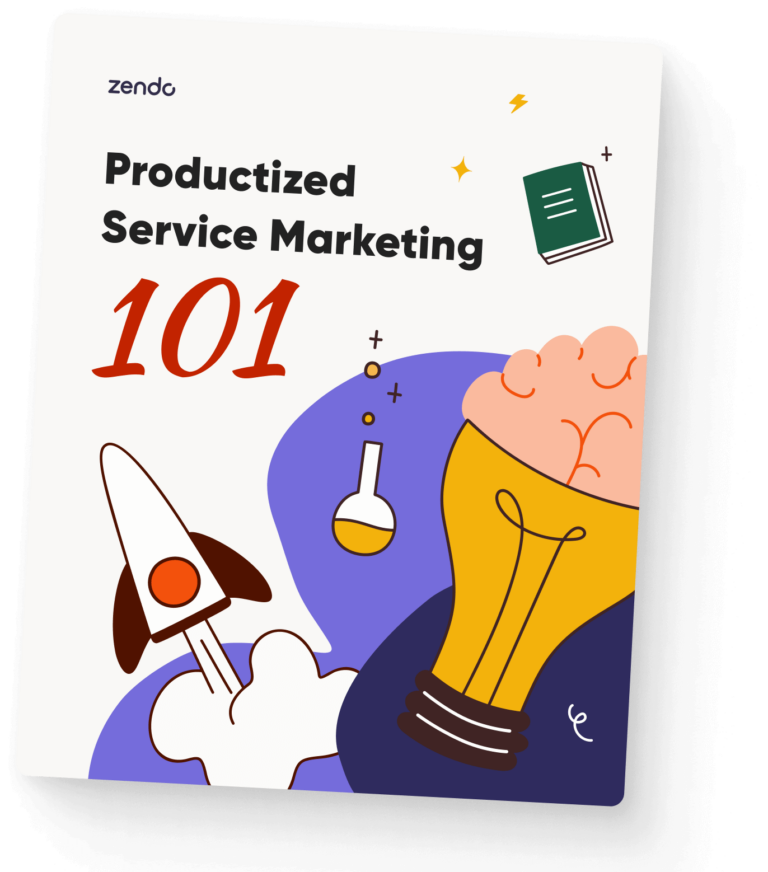What does Fred Krieger, Scoro’s CEO, have in common with Christopher Nolan?
They are both obsessed with the concept of time.
And for a good reason — time is money, after all. But since it flies by so fast and slips through fingers way too easily, it’s more difficult to measure. And because of that, it’s less valued than money.
After all, if you lose some of your money, you can feel that pain immediately; but losing a few hours on watching TikTok videos? Doesn’t hurt as much.
And it especially doesn’t seem like a waste of money if you think that you spend your time productively. For example, by personalizing your Trello boards, coming up with a new organization system for your files, or watching yet another productivity video to finally find out the holy grail of effectiveness.
But if you’re aware of the productivity trap and value your time, you might want to follow in Krieger’s footsteps and focus on what truly makes a difference in your business.
Greg McKeown echoes that sentiment in his book “Essentialism”: you shouldn’t focus on how much you can do in the shortest amount of time possible, but rather on getting the right things done.
That’s where the client work management platform comes in. A place for you and your team that will handle most of your tasks automatically, leaving you free to focus on the actual work that will be delivered to your clients. You can forget about issuing invoices, manually changing statuses to let everyone know where the project’s at, or sending payment reminders.
Technology can do all that and more for you, as long as you allow yourself to be spoiled.
Both Scoro and Accelo offer you new ways of managing your business, if you let them. In this article, we’ll take a closer look at their features and see if there’s any other tool that could make up for what they lack!
Scoro: Introduction
Scoro was introduced to the world back in 2013 by Fred Krieger, who found himself in a dire need of a software that could help him track time and progress. But because he couldn’t find what he wanted, he decided to build one himself.
In 2023, Scoro managed to hit the milestone of reaching $12M revenue with the help of 151 professionals based in Estonia and $23.5M of funding.
Scoro describes itself as a “Comprehensive Work Management Software” that’s a good fit for many industries, from event management and architecture to consultants and IT, as well as for many roles — executives, project managers, financial managers, and more.
Scoro: Feature Analysis
To see how it fares in reality, you can sign up for a 14-day trial period, no credit card required.
Then, you’ll be taken through a short onboarding, where you can provide information to ease the pains of setup, including your role, your team’s size, industry, and more.
Onboarding
Before you settle in, Scoro will encourage you to go through its comprehensive guide.
In the Help Station, you gain access to a Knowledge Base, AI Chat (which is currently labeled as “Beta”), demo data that showcase the platform’s possibilities, and a list of first steps to help you set up.
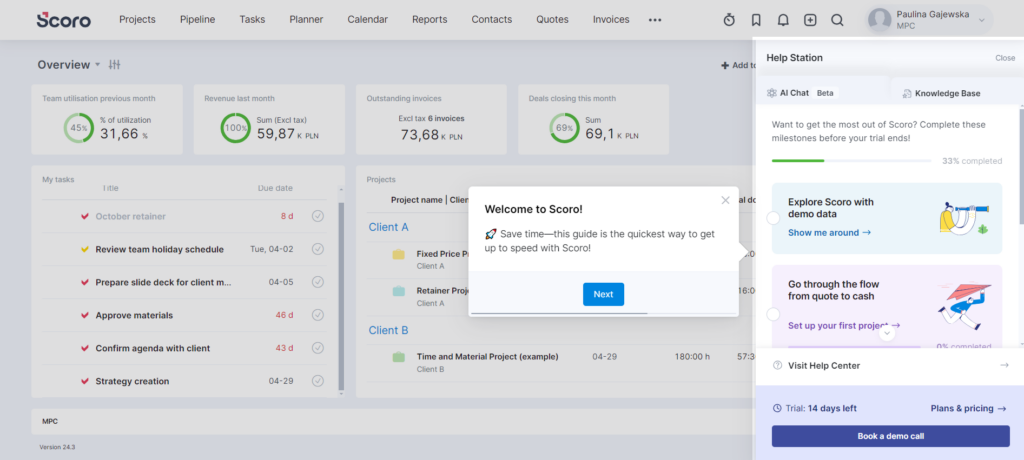
The onboarding process is detailed and exhaustive, interspersed with videos, images, and extra links to granular guides. Because Scoro is such a detailed platform with too many features to count, the onboarding becomes crucial in helping understand its ins and outs. Thankfully, Scoro doesn’t shy away from giving you the helping hand and does it with proper grace.
Also, the platform isn’t empty upon your first visit — it’s filled with demo data that helps you understand how features are supposed to work and how a daily life of a business looks like when it’s based on Scoro.
If you have had enough of the demo content and would rather start setting up your own data, you can easily delete it with a single click. Easy!
Team Management
Scoro goes all out when it comes to team management, which is great news for those that have large teams and want to keep track of every single thing concerning them, including labor costs, team utilization statistics, or availability.
First things first, user permissions. You can either use pre-existing roles, like “Finance” or “Project Manager”, or create custom ones, which then can be assigned to other users. This way, you can easily manage who sees what parts of the software, without fearing that someone might access sensitive information.
Then, you can assign labor cost to each role. You can also set up a default labor cost and individual one for each user, so it’s really up to you what you prefer.
By entering the labor cost, you’ll be able to properly measure the projects’ costs and analyze their profitability, so this feature might turn out to be crucial in making further decisions.
Then, you can measure team usability and performance. There are several different reports that can help you understand what’s up with your team: there are utilization forecasts that you can use to check on your team’s workload in the coming weeks and months, or you can view data that shows how much time was spent on billable and non-billable clients. Or you can simply take a sneak peek of your team member’s timesheets to see what eats away at their time.
You can also compare different time periods across all the reports to notice any patterns or discrepancies. This feature will make you squeal if you love analyzing your business in-depth.
Overall, out of all the software we’ve analyzed so far — and we’ve analyzed many of them — this project management tool for professional service businesses offers a lot to those that thrive in team management roles.
Let’s see how other features compare!
Project Management
The set of project management features in Scoro also has much to offer in terms of numbers and reports.
When you go to the Projects tab, you’ll see an accurate overview of all your projects, which can be filtered and grouped in various ways. For example, you can group the list by multiple clients, only view projects with a specific project status (like “On hold” or “Pending”), or by incoming deadlines.
In the same view, you already get a hefty amount of information: due dates, progress bars, income, labor costs, and project profit are already shown, so you can quickly get to speed on where the money’s going and coming from, as well as how much is left to do.
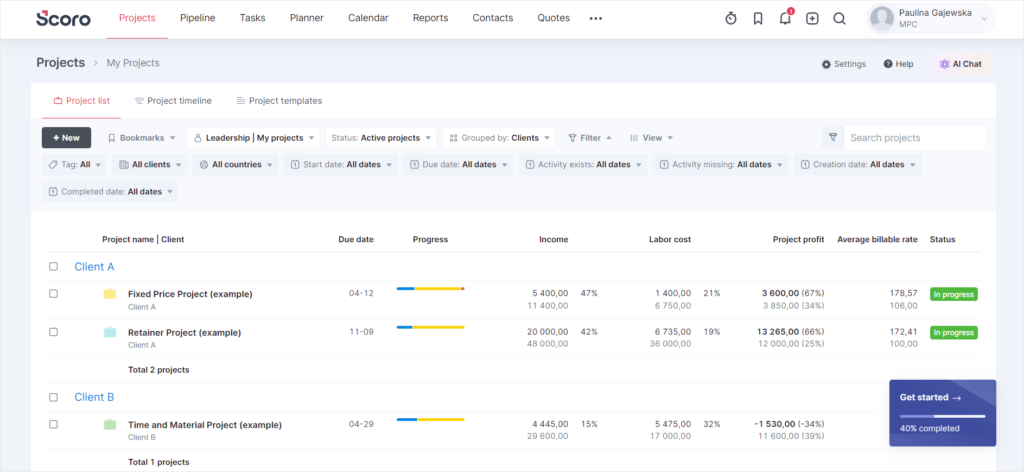
Once you go to a specific project, the amount of information accessible right at hand might surprise you.
First of all, you get to see all the numbers pertaining to time — how many hours were used in hours and percentages, how many hours remain to complete the project, and how many days are left before the deadline.
Then, you can switch between different tabs to access more information:
- Tasks: here, you can see all the tasks grouped by phases, their status, progress bar, due date, time spent, and remaining time.
- Budget: useful for checking on revenue forecast, profit that includes the labor costs defined when assigning roles, burn-up, and quotes vs actual table that help you see if you’re not straying too far from plans, money-wise.
- Time: made for checking on the time log and seeing how much time and money specific tasks required so far.
- Finances: in this tab, you can take a quick look at all the documents, including quotes, invoices, bills, expenses, and purchase orders.
- Details: here, you can look up extra project information, files, custom fields, and related contacts.
- Comments: this tab is meant for exchanging simple comments, where you can also mention other users, notify them of new replies, as well as share files and links.
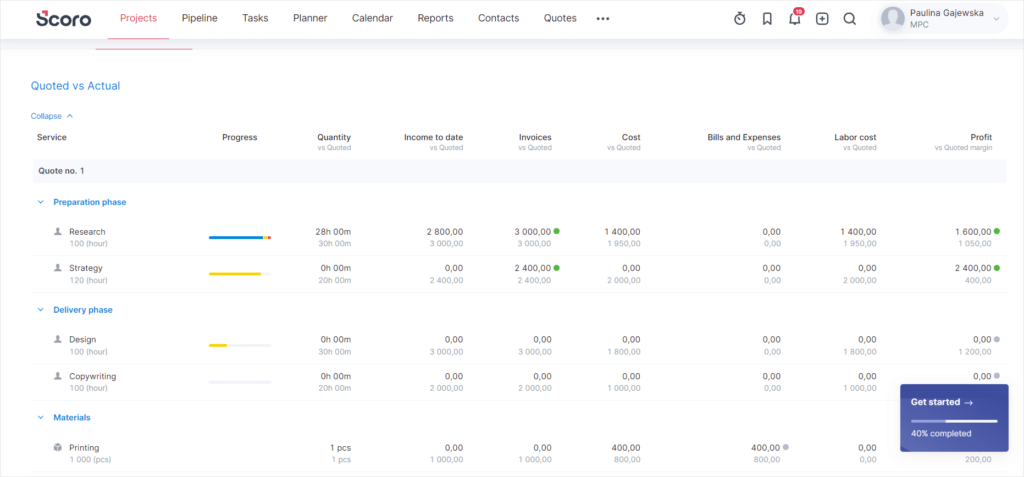
If that wasn’t enough, you can switch between five different views when checking on your routine tasks: standard list, list that includes only events, Gantt, a Kanban-like board, and a calendar. This way, everyone can use their favorite views and they don’t have to worry about updating each one — all views are being updated in real-time, automatically.
Selling Services
Through Scoro, you can sell both products and services. There are several ways of pricing them on the platform.
- Flat fee pricing: used best when you know upfront what the overall price for the offer should be and don’t plan to charge more, which makes it perfect for products or productized services (for example, logo design or article writing),
- Service-based hourly rate pricing: in this case, you’ve defined the hourly cost of a specific service — for example, a website maintenance — so that you can prepare a quote based on the estimated number of hours needed to deliver the service,
- Role-based hourly rate pricing: here, you’ve defined the hourly cost of an employee — let’s say, a UX/UI Designer — and are willing to rent them for a client’s project on a temporal basis; so the quote you prepare is based on the estimated number of hours your client will need the designer for.
Once you made your choice, you can package your product or a service with a fitting title, description, links, images, and others. You can also set up a default doer, if the specific type of work is usually managed by the same person.
With all that set in place, you can create a new quote and pick your just created service or a product right there and send it to your client.
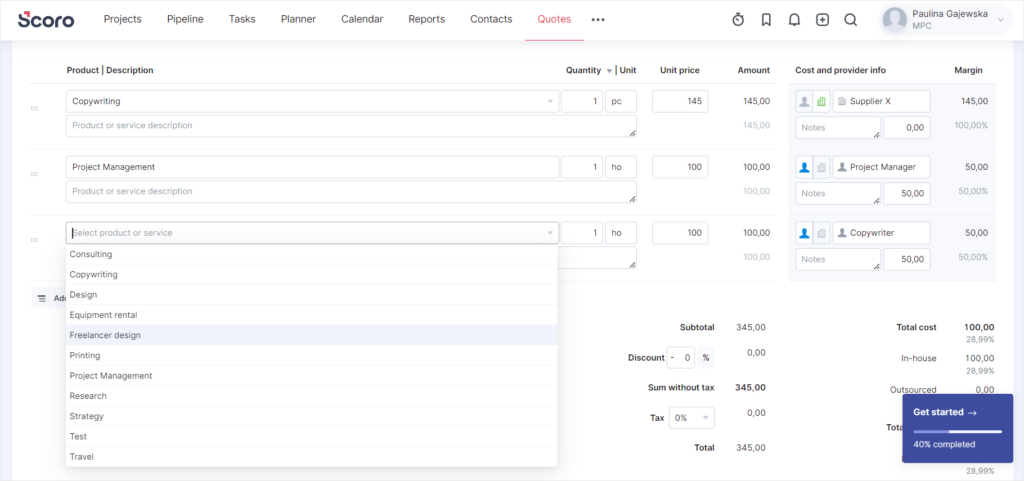
On one hand, the process of setting up your offer is fairly straightforward, but compared to team and project planning & management, it pales in comparison in terms of available options. It’s clear that the emphasis is put on the management features, and not on selling services.
This also means that Scoro is best used with other tools or a separate website, where you can tempt potential customers with your offer and explain all the relevant terms and conditions there.
Scoro also serves better as an internal tool than a Client Portal — so if you were looking to find something that combines both, you’ll have to try your luck elsewhere!
Subscription Plans
How much do you have to pay to access all the best Scoro has to offer?
There are four subscription plans to choose from:
- Essential: for $28 per user a month, you get the basic features that allow you to create your offer, close the deals, manage your team and clients, and get detailed work reports.
- Standard: for $42 per user a month, you unlock Gantt charts, phases, and milestones, as well as a time tracker, repetitive tasks, triggers & actions, detailed financial reports, and project templates.
- Pro: for $71 per user a month, you additionally purchase a planner, project budgets, timesheets and time locking, billable time tracker, labor cost and utilization reports, as well as sales pipeline & report.
- Ultimate: the last plan is up for negotiation. This plan includes single sign-on, company budgets and forecasts, unlimited custom fields, a customer portal, WIP report, FTP integration, and more.
While the pricing doesn’t look too expensive at a glance, the costs stack up the more users you plan to introduce to Scoro. Then, it can quickly turn into a huge investment that will swallow up your finances.
You can read up more on Scoro’ pricing in another article of ours, where we go more in-depth into each plan and available features.
Accelo: Introduction
Accelo is a Client Work Management Platform that promises to help increase both productivity and profitability.
Accelo is much older than Scoro. Its humble beginnings started as a side project in 2009, which then was officially launched in 2011 under a different name, AffinityLive. Four years later, the platform got rebranded as Accelo.
Geoff McQueen, Christine Higgins, Eamonn Bell, Glenn Fowler, are the founders behind Accelo’s success. Its yearly revenue is estimated at $14.8M per year, with funding of $11M.
Accelo: Feature Analysis
Now, if you want to check out this tool yourself, you can try it for free for 7 days, which is substantially less than Scoro.
When signing up, you are asked several questions so that the Accelo team can get to know your business. Then, you can start using the software!
Onboarding
Unfortunately, Accelo doesn’t introduce that much of the demo content that could be helpful in understanding how the platform should be used. There are two projects, one ticket, almost two dozens of tasks, and one example client.
There’s also no real onboarding that would take us slowly through the platform, highlighting the most important features and offering video recommendations. Here, you’re on your own — but that might be a plus in the eyes of more independent users.
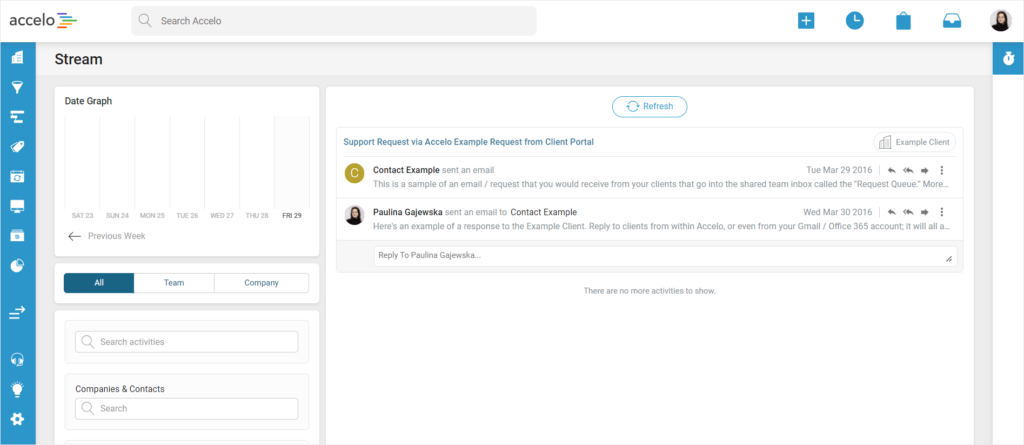
If you do need help, you can select the buoy icon in the bottom left corner to access Accelo’s help site, live chat, and Success Services, which promise to help you with setup and training — and if you really need special assistance, there are three support plans you can enquire about.
Now, if you want to get rid of the existing demo content, even though there’s not a lot of it to begin with, you have to do it manually.
Team Management
To invite your team members, you can either export the users from your G Suite domain or you can add users manually.
When doing the latter, there are many fields and options awaiting you; from basic information such as first and last name to position, who manages that person, what are their skills, their default billable and cost rates, time zones, and others. You can also add them to groups, assign access levels, and set their username and password. Last but not least, you can decide how much financial data they should see.
When it comes to permission levels, you can use the default ones, such as project managers, contractors, or sales & accounts, among others, or you can create your own.
The confusing part here is that you don’t create a new permission level or a role, but a group. Nevertheless, the options themselves when it comes to access are quite rich. You can, for example, make the following decision:
- Who can edit other users’ passwords,
- Who can create new users,
- Who can update activity cost rate,
- Who can view the utilization dashboard,
- Who gains the admin-level privileges,
- And more.
Now, how can you track your team’s progress and productivity?
Similarly to Scoro, you can also access different reports to check on many aspects of your business.
You can view tasks over budget, overdue tasks, as well as active ones. There’s a special report to compare planned vs actual work done and you can take a peek at task budget use.
All reports are automatically updated once per hour, to ensure all data is up to date and you’re not making any important decisions based on outdated information.
Project Management
When it comes to projects, you can view all the open ones in a list form and filter them as you need. You can only view those with specific tags or skills, for example, by project progress, financials, contacts, and others. While the UI itself is a bit clunky, you can still manage your view properly to get important insight.
You can also manage your columns to see more information at a glance. You can include: project progress, deadlines, total cost, service cost, overdue task count, progress bar for tasks, total billable time logged, and more.
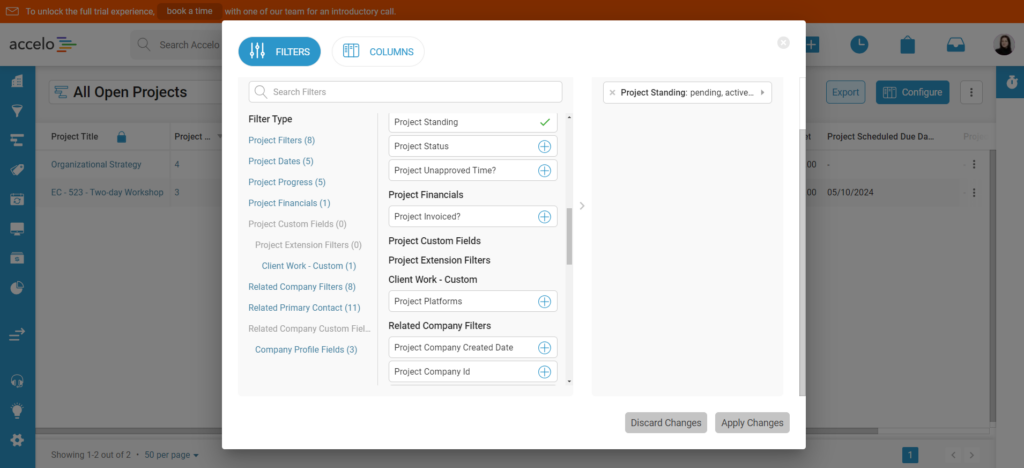
When you go to a specific project, you’ll access all the information pertaining to the project, including tasks, important dates, progress bar, attachments, schedule, expenses, contributors, comments, and more.

While there’s a lot of data you can access, we have to admit that it could have been presented better. Compared to Scoro, Accelo doesn’t have the same modern feel — it looks quite outdated, in fact — loads much slower, and there are many tabs to switch between to get what you want.
Taking all that into account, we can assume that Accelo aims to steal the hearts of enterprises, which are used to cumbersome software like SuiteDash.
As was the case with team collaboration and management, project management in Accelo also includes reporting. You can check project budgets, project time budgets, milestone budget usage, project profitability, project WIP, and others.
Selling Services
Now the most pressing question is, can you use Accelo to sell custom, productized, or subscription-based services?
Not exactly. Accelo helps you manage and track your sales, but you don’t really create your services or products that your clients can buy directly on the platform.
But there is a Client Portal you can make use of.
Client Portal is an excellent feature for increasing customer satisfaction and engagement, all while giving you a much more professional look. While there’s nothing wrong with exchanging back-and-forth emails between the vendor and their client, it makes for quite a workload that can be eased when customers can log in to their own platform to check on their projects.
On Accelo’ Client Portal, your customers can make sure that everything goes according to plan, as well as view their documents, such as quotes and invoices, access shared files, look up projects and tickets.
Moreover, you can customize the Client Portal by adding your own brand materials, changing dashboard colors, and including a welcome message.
Subscription Plans
Accelo offers four different subscription plans that can influence your decision whether to invest in it or not.
The plans are:
- Professional: for $50 per user a month, with the caveat that you need at least 7 users to start with, you get all the features necessary for basic client management, from projects and sales to quotes, invoices, time logs, and financial insight dashboard.
- Business: for $70 per user a month, with the minimum number of users being 7, you also get client retainer and ticket management, shared request inbox, expenses and materials, time approvals for billing, and unlimited client portal users.
- Advanced: for $90 per user a month, with no less than 10 users, gives you access to advanced custom workflows, advanced triggers and automation, client asset management, advanced reporting users, and smart scheduling along with utilization.
- Elite: only for those willing to negotiate, because this plan comes with custom pricing. On top of everything else in other subscription plans, it also includes divisions module, unlimited collaborator users, premium support with SLAs, dedicated account manager, Enterprise SSO, and role based users.
Accelo, surprisingly, is even more expensive than Scoro, despite the fact it both looks and works much worse. Not only that, it also forces the users to start off with a concrete number of users, so teams with fewer than 7 members won’t be able to use Accelo at all.
Scoro vs Accelo: Conclusions
Scoro and Accelo might look like similar enough tools at a glance, but it couldn’t be farther from the truth. Both offer slightly different features to cover the needs of different businesses, so let’s recap what we’ve learned so far.
- Scoro puts emphasis on micromanagement, especially when it comes to teams and finances. That’s why this software would best be used by Team Leaders, Project Managers, and Finance Managers to keep track of everything that happens in the company, from who’s going on holidays to who’s going to be soon too overworked to work efficiently. Considering the pricing, it’s a good choice for medium businesses, or even enterprises.
- Accelo focuses on client management and will make sales & account managers and specialists especially happy. All the client-oriented data will help them close their deals faster and more efficiently, all while keeping track of any backlogs, bottlenecks, patterns, and blockers alike. Mind you, it’s UI is a bit outdated and the platform can be quite slow.
If you’re a small to medium business owner who simply wants to focus on selling custom, productized, or subscription-based services, both of these options might be a bit disappointing — you don’t need so many reports or forecasts, and you’d rather focus on making actual money.
That’s why we have a sweet alternative for you, that’s both easy-to-use, affordable, and suitable for smaller teams!
Zendo: Putting Focus On What Matters The Most
If you’re looking for something much simpler, a tool that discards micromanagement yet supports teams all the same, you might want to take a closer look at Zendo.
This client work management platform helps small to medium businesses sell custom, productized, and subscription-based services, while also serving as a Client Portal for your customers to submit new orders, look up their projects, and converse with the team. Moreover, Zendo will help you craft your delivery process from top to bottom, meaning the moment your client browses the Service Catalog to the moment you send over files and invoices.
So if you care more about delivering the best possible customer experience than admiring your team member’s timesheet and getting lost in creating project templates, sign up for Zendo’s Essential plan, which is 100% free, and take your time to test all its features!

A free online training. Delivered daily to your inbox to grow your productized agency.
What Is Scoro?
Scoro is a project management tool with robust reporting and resource management capabilities. It was founded back in 2013 by Fred Krieger to help businesses save time and manage what’s left of it. It’s a great solution for Finance and Project Managers who like to micromanage their teams, from checking on their time logs to watching over progress bars and many, many charts.
What Is Accelo?
Accelo is a project & task management platform, useful in team management. It gives you a broad overview of all your projects, including their budgets, milestones, project deliverables, time logs, and more. It may look a bit outdated, but its client management capabilities might delight Sales teams all over the world.
What Is Better, Scoro vs Accelo?
Both tools, while they may seem similar, satisfy different needs: Scoro is better suited to Finance and Project Managers, while Accelo will thrive in the hands of a Sales team. Considering the pricing of both, the investment may greatly vary for different teams; both tools base their pricing on team seats. Also, Accelo won’t accept any teams with fewer members than 7.
What Is Zendo?
Zendo is a great alternative to both Scoro and Accelo. It’s modern, easy to use, and focuses more on client communications, delivering comprehensive customer experience, supporting team collaboration, and selling services. If you’re looking for an agency management tool that will substitute your communication tools, and which allows all parties to view project status, assign tasks, send documents, and make payments directly in chat, Zendo may be the perfect solution!










